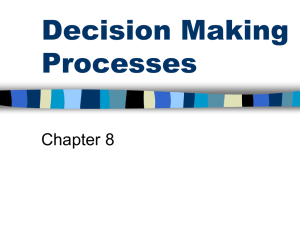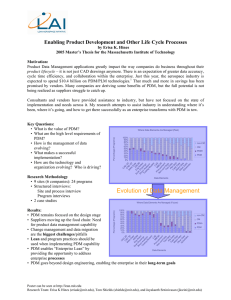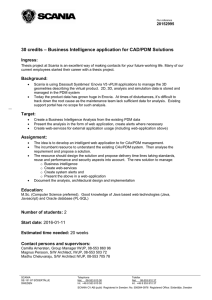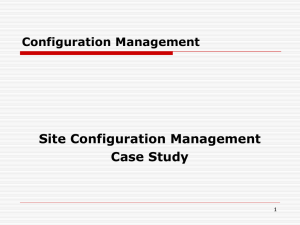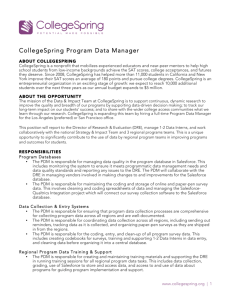CHAPTER 1 INTRODUCTION 1.1
advertisement
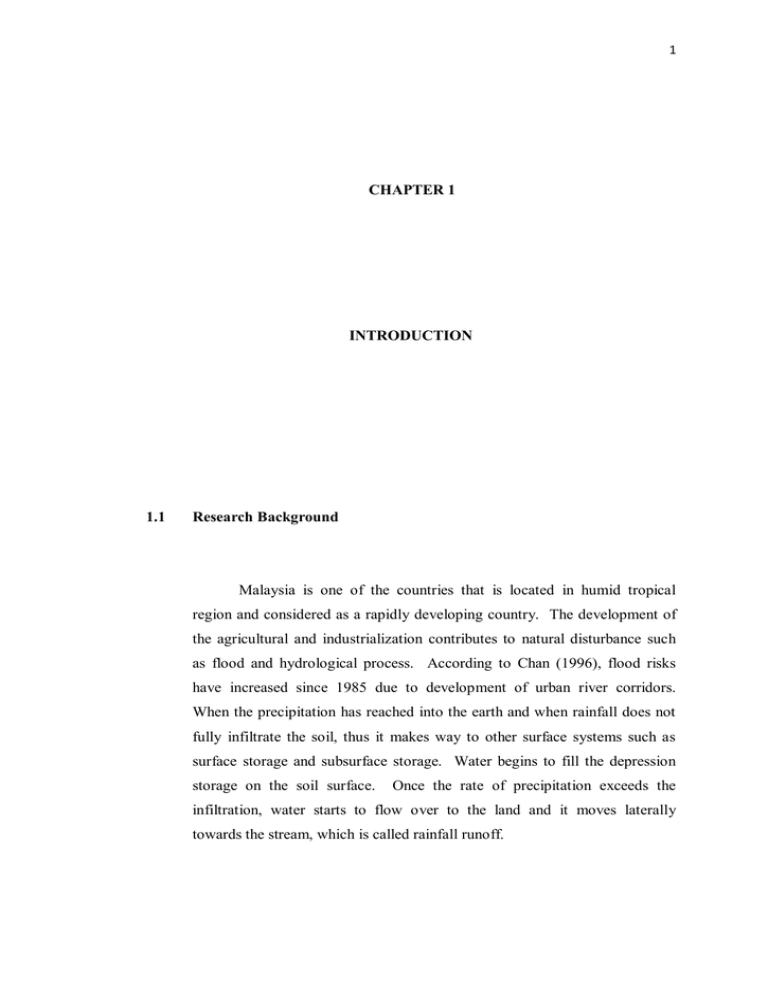
1 CHAPTER 1 INTRODUCTION 1.1 Research Background Malaysia is one of the countries that is located in humid tropical region and considered as a rapidly developing country. The development of the agricultural and industrialization contributes to natural disturbance such as flood and hydrological process. According to Chan (1996), flood risks have increased since 1985 due to development of urban river corridors. When the precipitation has reached into the earth and when rainfall does not fully infiltrate the soil, thus it makes way to other surface systems such as surface storage and subsurface storage. Water begins to fill the depression storage on the soil surface. Once the rate of precipitation exceeds the infiltration, water starts to flow over to the land and it moves laterally towards the stream, which is called rainfall runoff. 2 There are many rainfall runoff models that are widely used such as TOPMODEL, TOPKAPI, Horton Overland Flow Model and Hewlett Runoff Model (Keith J. Beven, 1997). However, this study focused on Probability Distributed Model (PDM) that has a main role in analyzing the hydrological behavior. PDM has been widely used in many countries such as England, Hong Kong, India and others (Young and Reynard, 2004; Blyth and Bell, 2004; Moore, 2007). This model has been implemented in numerous processes, such as runoff production, subsurface storage, groundwater recharge and others. PDM was discovered in the 1960s by researchers. According to Moore and Clarke (1981), PDM has no actual estimation between the distribution of storage and characteristics of catchment. Then, this research was continued by Hosing and Clark (1990), Moore (1985) and Clarke (1983). PDM model is not only targeted on the surface runoff but also applied on snowmelt model, macro scale hydrological model and others. This research focused only on Johor River, Malaysia. According to Department of Irrigation and Drainage (DID), Johor, major floods occurred over the past decades and also most recently in December 2006 and January 2007. In addition, it caused massive flooding and sometimes destroyed properties and killing people at each year. 1.2 Problem Statement The factors that are considered in flood occurrence in Johor are topography, topographic slope, soil, land use, climate change, lithology, drainage and human factors. These factors were determined by previous researchers (World Meteorological Organization, 2008). The management of poor dams and the storage capacity has to be considered so that we can reduce the frequency of having floods in selected area. Although there are many models discovered in flood prediction, the problem still remains. Therefore, Probability Distributed Model (PDM) would be used for Johor 3 Bharu River so that the factors can be minimized or overcome to reduce the flood occurrence problems. 1.3 Objectives of the Study The objectives of this study are: i. To apply PDM model with Pareto distribution to represent the storage capacity to Johor river basin. 1.4 ii. To assess the performance of the model. iii. To validate the model by predicting the future water level Scope of the Study By using Lazarus software, the Probability Distributed Model (PDM) software is utilized in analyzing the hydrological data. In this study, the data sets consist of inputs and outputs needed in analyzing the hydrological data. Therefore, a part of watershed located in Johor, Malaysia has been selected in this research. Hydrological data and digital topographic data were acquired from Department of Irrigation and Drainage (DID), Hydrological Unit and Department of Survey and Mapping Malaysia (JUPEM). 4 1.5 Significance of the Study The purpose of the study is to show on how Probability Distributed Model (PDM) is used in solving the problems of flood by applying some PDM techniques to the problems. In this study, we used Probability Distributed Model (PDM) to get a better and precise model in forecasting the frequency of flooding in Johor Bharu areas and also give important contributions to the hydrologist. PDM model is different than other models because the storage capacity is assumed to be distributed using the probability distribution. PDM model is also well-structured compared to the concepts of other models (Willems et al., 2001). In forecasting the process, PDM model would be updated by using state correction and error prediction techniques either in offline forecasting or real time forecasting. Besides that, PDM model also represents a broad range of runoff behavior by using a minimum number of model parameters. 1.6 Organization of the Report This report consists of six chapters. Chapter 1 provides an introduction to the research study as an overview of the current research. It consists of the background of the study, problem statement, objectives, scope and significance of the study. Chapter 2 discusses the literature of the study. This chapter then continues by presenting historical researches of the rainfall characteristics, climate, weather and seasons of Malaysia, runoff characteristics, hydrologic process, hydrologic modeling, surface runoff, and forecasting technique. The research methodology is presented in Chapter 3. In this chapter, we will give some illustrations about how the Probability Distributed model (PDM) model behaviour is used. In this chapter also describes the research methodology about forecasting process. The data analyses are presented in Chapter 4 and Chapter 5, where the results are discussed in detail. Finally, Chapter 6 presents the summary, conclusions and recommendations for future study.
